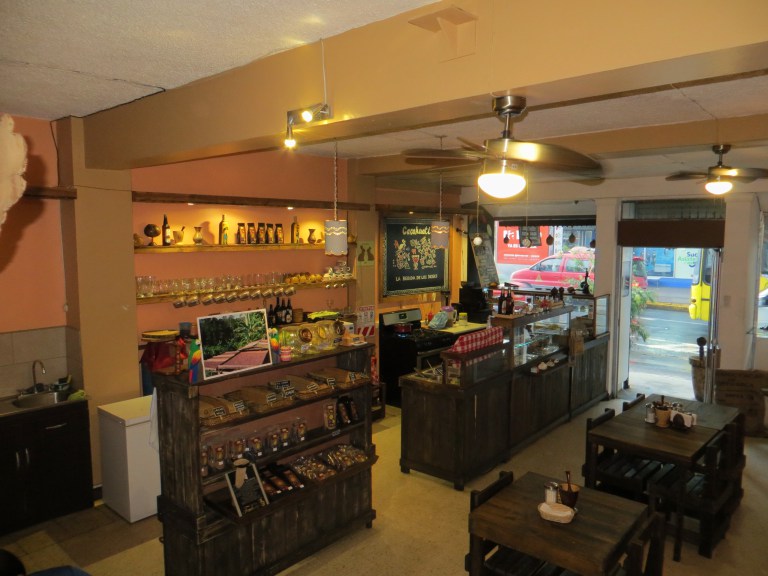Costa Rica Things to Do – Most people know that Costa Rica grows some of the best coffee in the world. But it comes as a surprise to many, that Costa Rica has also become one of the world’s leading sources for excellent quality gourmet chocolate. In fact, some very fussy up-scale chocolatiers in the United States will only use Costa Rican-grown chocolate.
 Those of us who live in this beautiful country are lucky. We have access to Costa Rica’s world-class chocolate from many different sources. If you live in, or visit, Downtown San Jose, you are even luckier: You can actually make your own chocolate.
Those of us who live in this beautiful country are lucky. We have access to Costa Rica’s world-class chocolate from many different sources. If you live in, or visit, Downtown San Jose, you are even luckier: You can actually make your own chocolate.
One of the pleasant surprises that we have discovered in Downtown San Jose is La Casa del Cacao de Costa Rica (The Costa Rican House of Chocolate). This storefront on Calle 11 is a wonderful combination of a coffee shop and a restaurant and a chocolate factory and a chocolate school. That’s right: A chocolate school.
The House of Chocolate was created one year ago, by Cedric Begein, a recent immigrant from Belgium. “During my childhood, I always loved eating chocolate.” Cedric told us recently. That love of chocolate drew him to Costa Rica, and he soon opened this innovative business.
When you walk into the House of Chocolate, your first impression will be that you have entered a perfectly nice cafe and Tico-style restaurant; with an emphasis on chocolate, of course. It is only after you have been taken up to the second floor, that you will understand what a unique place this is.
On the second floor, there is a small classroom, called The Chocolate Workshop, where you can learn about the history of chocolate, you can learn how to cook with chocolate and you can actually learn how to make your own chocolate bars.
I had always thought that chocolate originally came from Africa. It is actually native to the Amazon basin. During pre-Columbian times, some indigenous tribes used the raw cacao beans as a form of currency. Chocolate was used by the Incas, the Aztecs and the Mayans. Often, a strong chocolate beverage was drunk to embolden warriors before battle. It was considered the “drink of the gods.”
In the upstairs workshop, instructor, Angel Garcia, will show you how to take raw cacao beans and toast them. Then, using a traditional grinding stone called a metate, you will prepare your beans to make candy. Angel will take you through each step in making your own delicious chocolate candy bar. For the final step, you will be able to add a variety of nuts, dried fruits, sprinkles and other delights to make the chocolate bar of your dreams.
The rest of the upstairs is a closed temperature-controlled room that is the chocolate factory. Here, Cedric and his staff make a variety of chocolate bars and bite-size gourmet candies. Cedric tells us proudly, that all of the raw cacao used in his store comes from an organic cacao farm near Limon, on the Caribbean side of Costa Rica.
In addition, La Casa del Cacao makes some chocolate novelty items such as a chocolate cell phone. These are very popular, and they make wonderful gifts.
You can visit La Casa del Cacao Monday through Saturday from 10 a.m. to 7 p.m. You can come in just for coffee or for a tasty Tico-style meal. Then, if you would like to learn how to make your own chocolate candy bar, you can ask to take the chocolate-making class. You will need to allow 45 minutes to an hour. Your chocolate-making class will cost $8.00 (U.S. dollars) per person. You have to admit, that is a good deal!
Classes can be conducted in English, Spanish and French. The chocolate workshop is big enough to accommodate up to 10 people.
Owner, Cedric Begein, tells us that they can also provide a more customized class for groups who want to learn about cooking with chocolate. If you would like a customized class, you should call for a reservation, and to determine the price. Call 8777-2326.
La Casa del Cacao de Costa Rica is located on Calle 11, between Avenida Central and Avenida 2. From the Chinese arch at Barrio Chino, go one block east and half a block north.
Michael Miller is the author of the first and only guide book that focuses on Downtown San Jose, Costa Rica, titled: The Real San Jose. An electronic version ofThe Real San Jose is available at Amazon/Kindle. To access it, CLICK HERE.
You can see additional stories that Michael has written about Downtown San Jose at his website: therealsanjose.com

